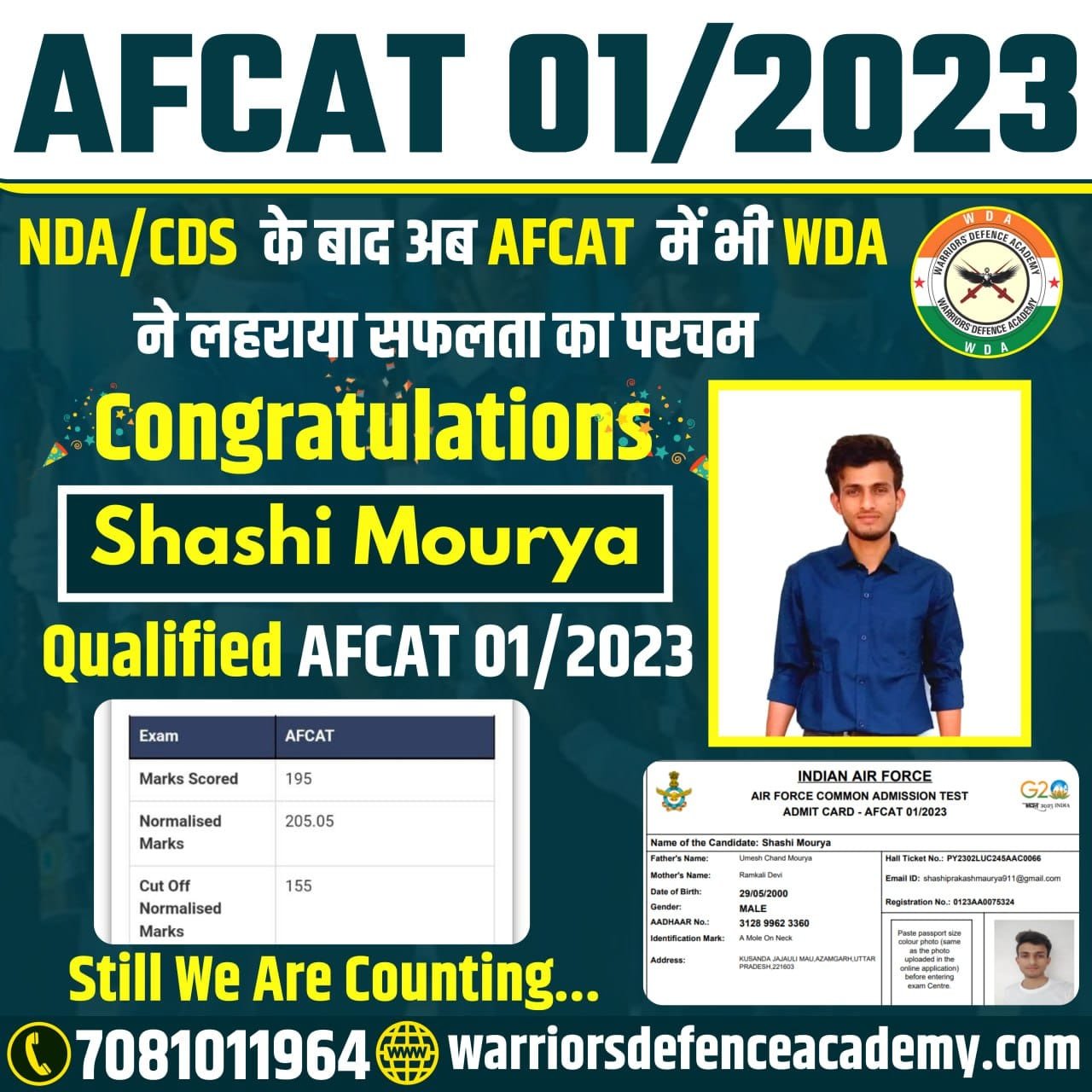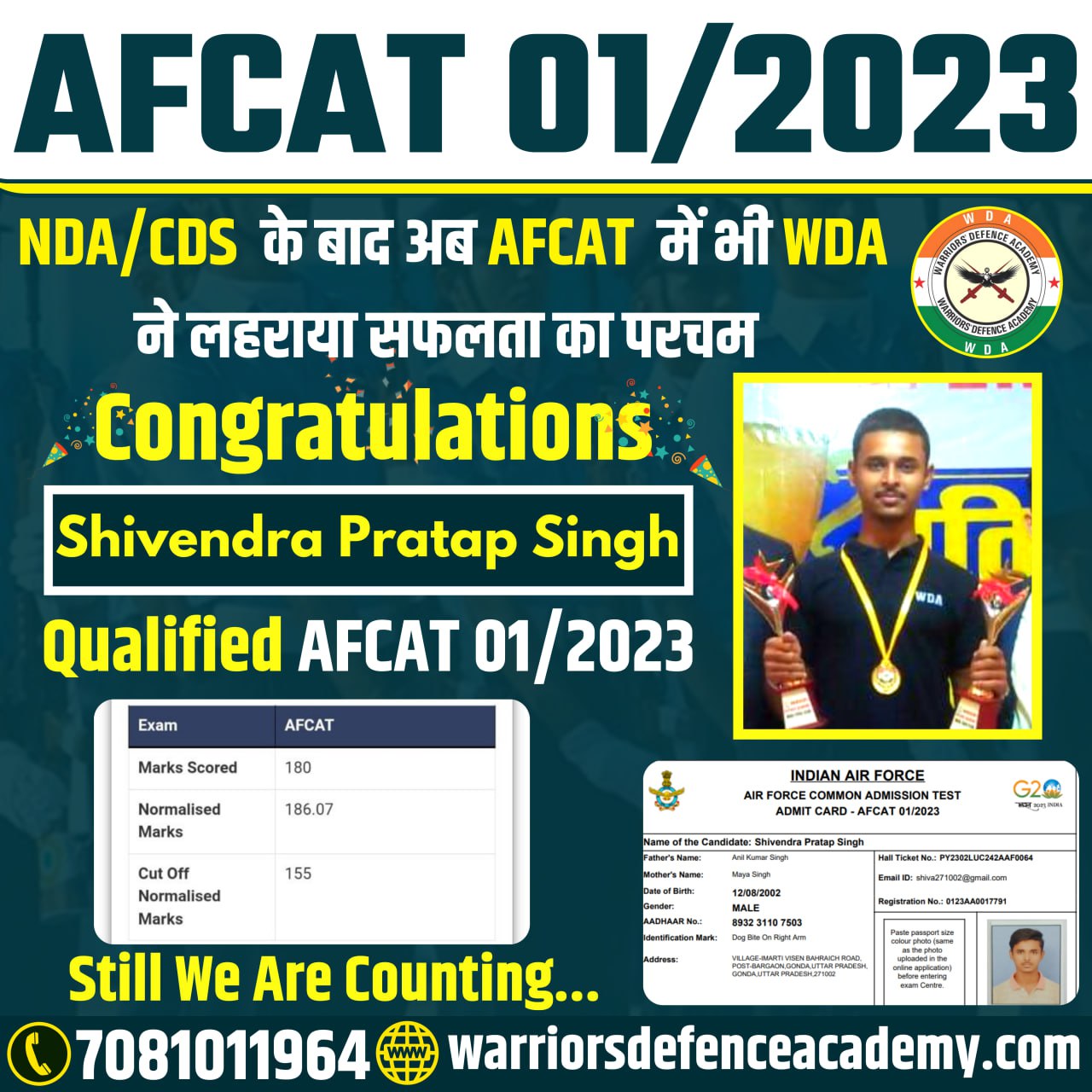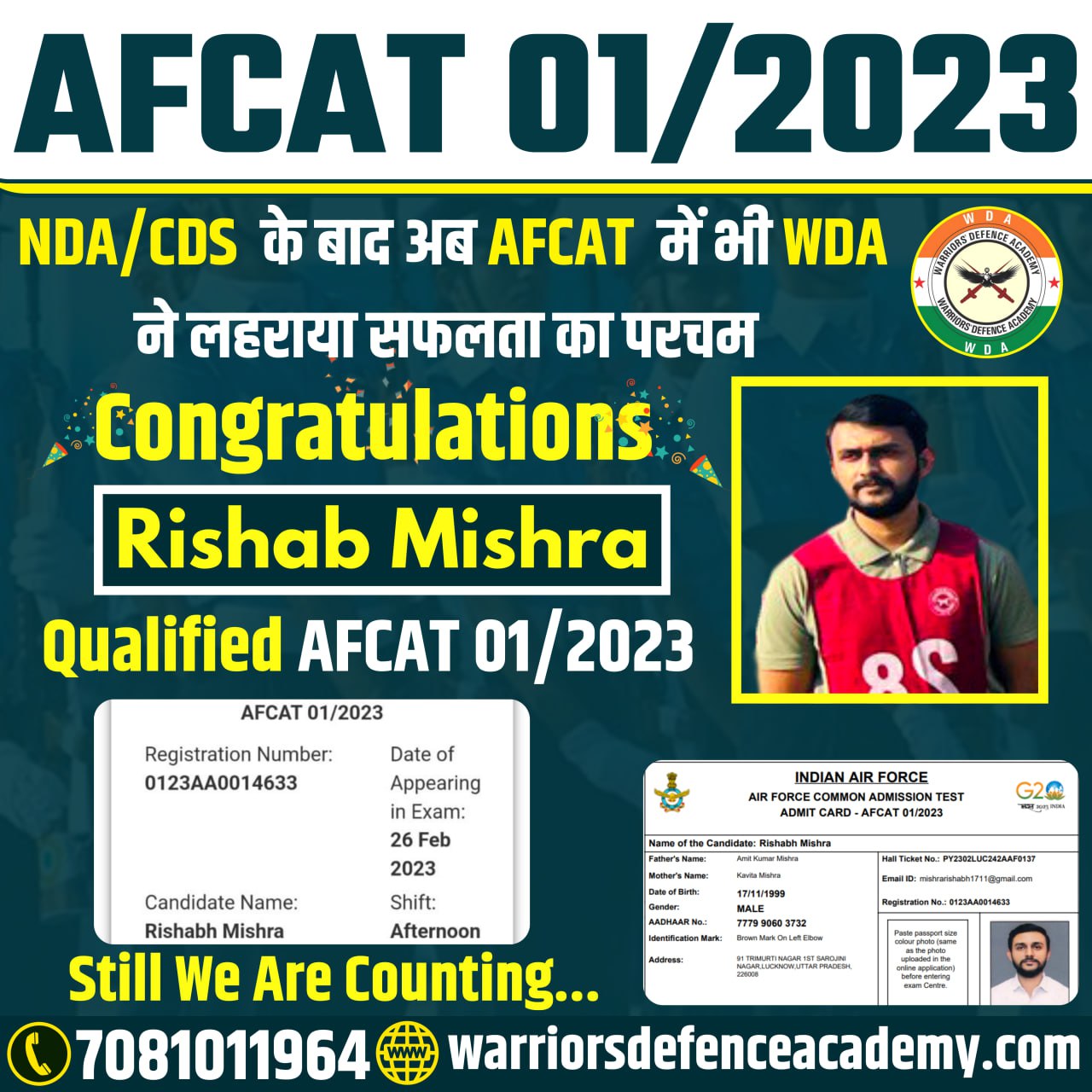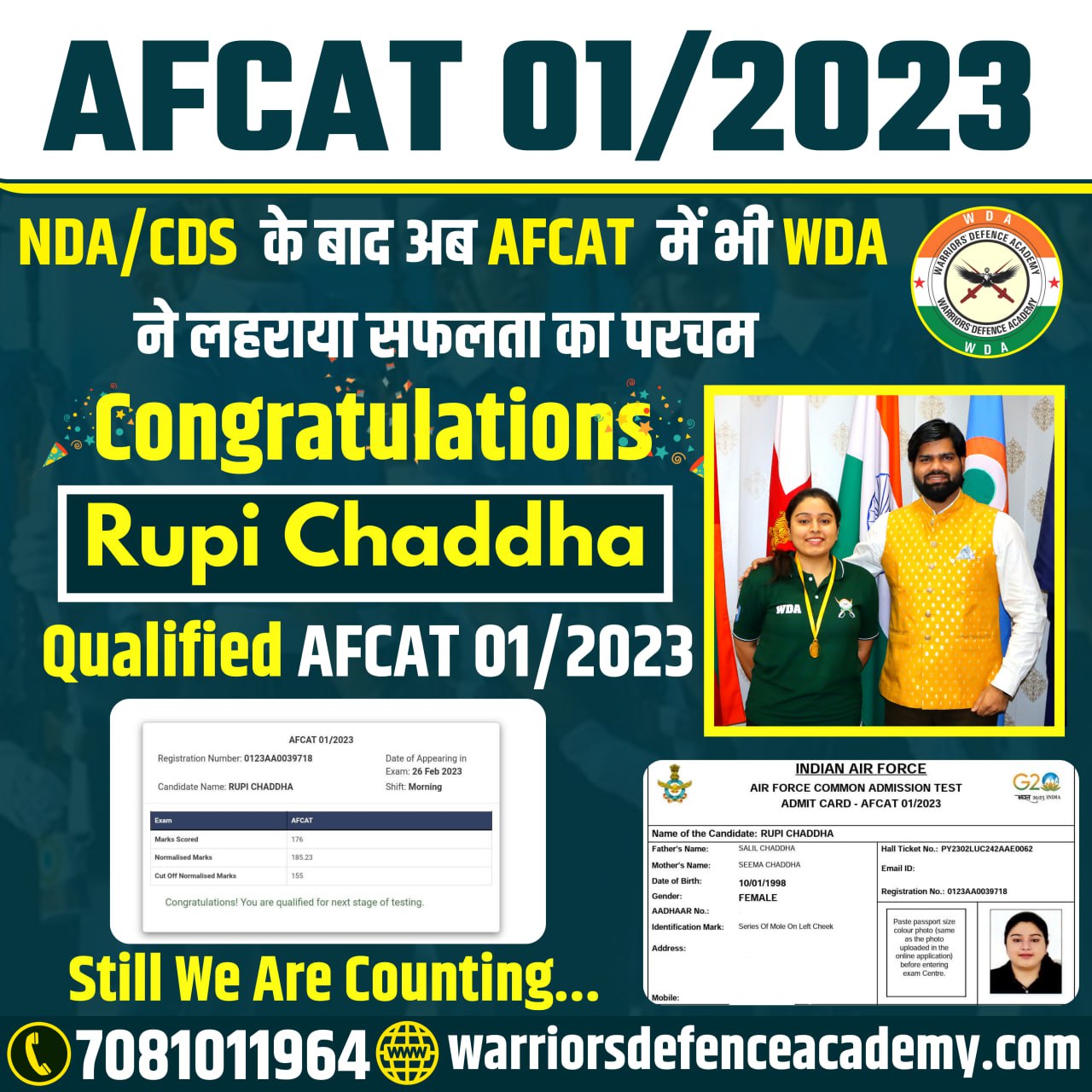Warriors Defence Academy is the Best NDA coaching in Lucknow. Success is the product of struggles. You must do what others don’t achieve what others won’t. And during this fight to achieve your dream of becoming the protector of our great nation, we the Warriors Defence Academy, the best coaching in Lucknow for NDA become a precursor for you to escort you through all of your fair cows.
We thank lady luck for smiling brightly upon us for she has procured the best of the best instructors that the world has to offer, who through their collective hard work and dedication towards students have made Warriors Defence Academy the best in NDA and CDS coaching in Lucknow. We are best defence coaching in Lucknow and best coaching for NDA and CDS Exams.
Best NDA Coaching in Lucknow
The prestigious National Defence Academy is Asia’s first joint service Academy which through rigorous training prepares the band of fierce warriors of land, air and sea who defends the glory and integrity of our nation.






Selection Procedure
To lay the foundation work Warriors Defence Academy, best defence coaching in Lucknow provides you with the best instructors who are themselves handpicked by our panto math director through a set of screening procedures and also with the specially designed infrastructure for training our students to crack the the world’s 8th toughest exam.
UPSC conducts NDA (National Defence Academy) Exam in Two Stages:
1.Written Examination
2.Interview
Since you are aiming to be the protector of peace it is absolutely imperative that your body is as sharp as your mind. For this reason, Best NDA Coaching in Lucknow, Warriors Defence Academy conducts regular physical training classes for our students to be a cut above all. This is additionally one more reason for ourselves the best coaching for defence services.
Eligibility Criteria
Age Limit: Applicants age must be between 16 ½ -19 ½ Years. See more details in notification.
Educational Qualifications:
- For Army wing of National Defence Academy: 12th Class pass of the 10+2 pattern of School Education or Equivalent examination conducted by a State Education Board or a
- For Air Force and Naval Wings of National Defence Academy and for the 10+2 Cadet Entry Scheme at the Indian Naval Academy: – 12th class pass of the 10+2 pattern of School Education or equivalent with Physics and Mathematics conducted by a State Education Board or a
Candidates who are appearing in the 12th class under the 10+2 pattern of School Education or equivalent examination can also apply.
How to Apply:
- Put the following web address in browser- upsconline.nic.in (UPSC Official Website).
Selection Procedure: Selection will be made on the basis of performance in written examination followed by Psychological Aptitude Test and Intelligence Test, SSB Interview.
Website: www.upsconline.nic.in
SYLLABUS
UPSC NDA GENERAL ABILITY TEST SYLLABUS
Part A – English
The question paper in English will be designed to test the candidate’s understanding of English and workman like use of words. The syllabus covers various aspects like : Grammar and usage, vocabulary, comprehension and cohesion in extended text to test the candidate’s proficiency in English.
Part B – General Knowledge
The question paper on General Knowledge broadly covers the subjects: Physics, Chemistry, General Science, Social Studies, Geography and Current Events.
The syllabus given below is designed to indicate the scope of these subjects included in this paper. The topics mentioned are not as exhaustive and questions on topics of similar nature not specifically mentioned in the syllabus may also be asked. Your answers are expected to show your knowledge and intelligent understanding of the subject.
Section A: Physics
Physical Properties and States of Matter, Mass, Weight, Volume, Density and Specific Gravity, Principle of Archimedes, Pressure Barometer.
Motion of objects, Velocity and Acceleration, Newton’s Laws of Motion, Force and Momentum, Parallelogram of Forces, Stability and Equilibrium of bodies, Gravitation, elementary ideas of work, Power and Energy.
Effects of Heat, Measurement of temperature and heat, change of State and Latent Heat, Modes of transference of Heat. Sound waves and their properties, Simple musical instruments.
Rectilinear propagation of Light, Reflection and refraction. Spherical mirrors and Lenses. Human Eye. Natural and Artificial Magnets, Properties of a Magnet, Earth as a Magnet.
Static and Current Electricity, conductors and Non-conductors, Ohm’s Law, Simple Electrical Circuits, Heating, Lighting and Magnetic effects of Current, Measurement of Electrical Power, Primary and Secondary Cells, Use of X-Rays.
General Principles in the working of the following:
Simple Pendulum, Simple Pulleys, Siphon, Levers, Balloon, Pumps, Hydrometer, Pressure Cooker, Thermos Flask, Gramophone, Telegraphs, Telephone, Periscope, Telescope, Microscope, Mariner’s Compass; Lightening Conductors, Safety Fuses.
Section B: Chemistry
Physical and Chemical changes. Elements, Mixtures and Compounds, Symbols, Formulae and simple Chemical Equations, Law of Chemical Combination ( excluding problems ). Properties of Air and Water.
Preparation and Properties of Hydrogen, Oxygen, Nitrogen and Carbondioxide, Oxidation and Reduction. Acids, bases and salts.
Carbon – different forms. Fertilizers – Natural and Artificial
Material used in the preparation of substances like soap, Glass, Ink, Paper, Cement, Paints, Safety Matches, and Gun-Powder.
Elementary ideas about the Structure of Atom, Atomic, Equivalent and Molecular Weights, Valency.
Section C: General Science Difference between the living and non-living. Basis of Life – Cells, Protoplasm’s and Tissues.
Growth and Reproduction in Plants and Animals.
Elementary knowledge of human Body and its important organs. Common Epidemics, their causes and prevention.
Food – Source of Energy for man. Constituents of food, Balanced Diet. The Solar System – Meteors and Comets, Eclipses.
Achievements of Eminent Scientists.
Section D: History, Freedom Movement, etc.
A broad survey of Indian History, with emphasis on Culture and Civilisation. Freedom Movement in India.
Elementary study of Indian Constitution and Administration. Elementary knowledge of Five-Year Plans of India.
Panchayati Raj, Co-operatives and Community Development.
Bohdan, Sarvodaya, National Integration and Welfare State, Basic Teachings of Mahatma Gandhi.
Forces shaping the modern world; Renaissance, Exploration and Discovery; War of American Independence. French Revolution, Industrial Revolution and Russian Revolution. Impact of Science and Technology on Society. Concept of one World, United Nations, Panchsheel, Democracy. Socialism and Communism. Role of India in the present world.
Section E: Geography
The Earth, its shape and size. Latitudes and Longitudes, Concept of time. International Date Line. Movements of Earth and their effects.
Origin of Earth. Rocks and their classification; Weathering – Mechanical and Chemical, Earthquakes and volcanoes.
Ocean Currents and Tides
Atmosphere and its composition; Temperature and Atmospheric Pressure, Planetary Winds, cyclones and Anti- cyclones; Humidity; Condensation and Precipitation; Types of Climate. Major Natural regions of the World.
Regional Geography of India – Climate, Natural vegetation. Mineral and Power resources; location and distribution of agricultural and industrial activities.
Important Sea ports and main sea, land and air routes of India. Main items of Imports and Exports of India.
Section F: Current Events
Knowledge of Important events that have happened in India in the recent years. Current important world events.
Prominent personalities – both Indian and International including those connected with cultural activities and sports.
Note: Out of maximum marks assigned to part ‘B’ of this paper, questions on Sections A, B, C, D, E and F will carry approximately 25%, 15%, 10%, 20%, 20% and 10% weightages respectively.
UPSC NDA MATHEMATICS SYLLABUS
- Algebra: Concept of a set, operations on sets, Venn diagrams. De Morgan laws. Cartesian product, relation, equivalence relation. Representation of real numbers on a line. Complex numbers – basic properties, modulus, argument, cube roots of unity. Binary system of numbers. Conversion of a number in decimal system to binary system and vice- versa. Arithmetic, Geometric and Harmonic progressions. Quadratic equations with real coefficients. Solution of linear inequations of two variables by graphs. Permutation and Combination. Binomial theorem and its application. Logarithms and their
- Matrices and Determinants: Types of matrices, operations on matrices. Determinant of a matrix, basic properties of determinants. Adjoint and inverse of a square matrix, Applications – Solution of a system of linear equations in two or three unknowns by Cramer’s rule and by Matrix
- Trigonometry: Angles and their measures in degrees and in radians. Trigonometrical ratios. Trigonometric identities Sum and difference formulae. Multiple and Sub-multiple angles. Inverse trigonometric functions. Applications – Height and distance, properties of
- Analytical Geometry of two and three dimensions: Rectangular Cartesian Coordinate system. Distance formula. Equation of a line in various forms. Angle between two lines. Distance of a point from a line. Equation of a circle in standard and in general form. Standard forms of parabola, ellipse and hyperbola. Eccentricity and axis of a conic. Point in a three dimensional space, distance between two points. Direction Cosines and direction ratios. Equation of a plane and a line in various forms. Angle between two lines and angle between two planes. Equation of a
- Differential Calculus: Concept of a real valued function – domain, range and graph of a function. Composite functions, one to one, onto and inverse functions. Notion of limit, Standard limits – examples. Continuity of functions – examples, algebraic operations on continuous functions. Derivative of function at a point, geometrical and physical interpretation of a derivative – applications. Derivatives of sum, product and quotient of functions, derivative of a function with respect of another function, derivative of a composite function. Second order derivatives. Increasing and decreasing functions. Application of derivatives in problems of maxima and
- Integral Calculus and Differential Equations: Integration as inverse of differentiation, integration by substitution and by parts, standard integrals involving algebraic expressions, trigonometric, exponential and hyperbolic functions. Evaluation of definite integrals – determination of areas of plane regions bounded by curves – applications. Definition of order and degree of a differential equation, formation of a differential equation by examples. General and particular solution of a differential equation, solution of first order and first degree differential equations of various types
– examples. Application in problems of growth and decay.
- Vector Algebra: Vectors in two and three dimensions, magnitude and direction of a vector. Unit and null vectors, addition of vectors, scalar multiplication of vector, scalar product or dot product of two-vectors. Vector product and cross product of two vectors. Applications-work done by a force and moment of a force, and in geometrical
- Statistics and Probability: Statistics: Classification of data, Frequency distribution, cumulative frequency distribution – examples. Graphical representation – Histogram, Pie Chart, Frequency Polygon – examples. Measures of Central tendency – Mean, Median and Mode. Variance and standard deviation – determination and comparison. Correlation and
NDA EXAM PATTERN
Scheme of Examination
- The subjects of the written examination, the time allowed and the maximum marks allotted to each subject are as follows
| Subject | Code | Duration | Max. Marks |
| Mathematics | 01 | 2.5 hours | 300 |
| General Ability | 02 | 2.5 hours | 600 |
- The papers in all the subjects consist of objective type questions
| SUBJECT | Maximum Marks |
| Paper • I Mathematics (Code No. 01) | 300 |
| Paper • II General Ability Test (Code No. 02) (Maximum Marks 600) | |
| Part A English | 200 |
| Part B General Knowledge | 400 |
General Knowledge has six sections with the break•up of 400 marks as below:
| Section | marks |
| Section for Physics | 100 |
| Section for Chemistry | 60 |
| Section for General Science | 40 |
| Section for History, Freedom Movement (Social Studies) | 80 |
| Section for Geography | 80 |
| Section for Current Events | 40 |
| Total | 400 |
A briefing on NDA Exam pattern is as under
| Exam Type/ Question Type | Objective Multiple choice with four options | ||
| Subjects | No. of Questions | Marks | |
| Mathemaics (Paper I) | 120 | 300 | |
| General Mental Ability • English and GK (Paper II) | 150 (50 for English and 100 for GK) | 600 (200 for English and 400 for GK) | |
| Total Questions | 270 | ||
| Maximum Marks | 900 | ||
| Marks for each Correct Answer | 2.5 – for Maths, 4 – for English, 4 – for GK | ||
| Negative Marks for Incorrect Answer | •0.83 – for Maths , •1.33 – for English, •1.33 – for GK | ||
| Marks for questions not attempted | Nil | ||
| Total Time for Exam (in minutes) | 300 (3 hours) |
